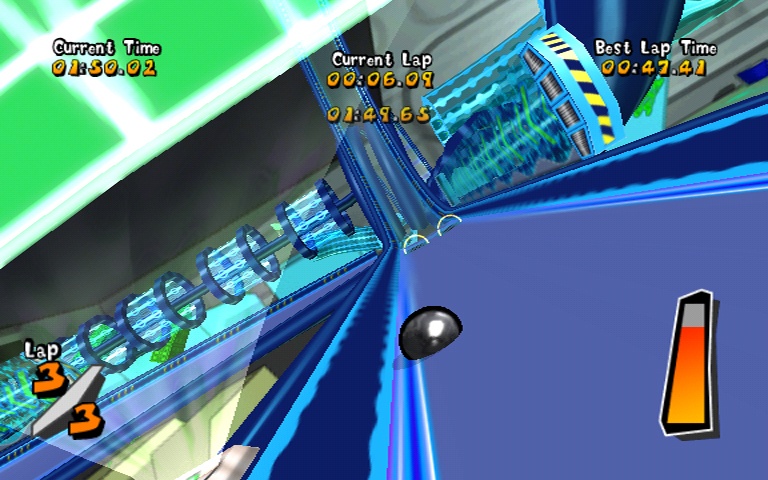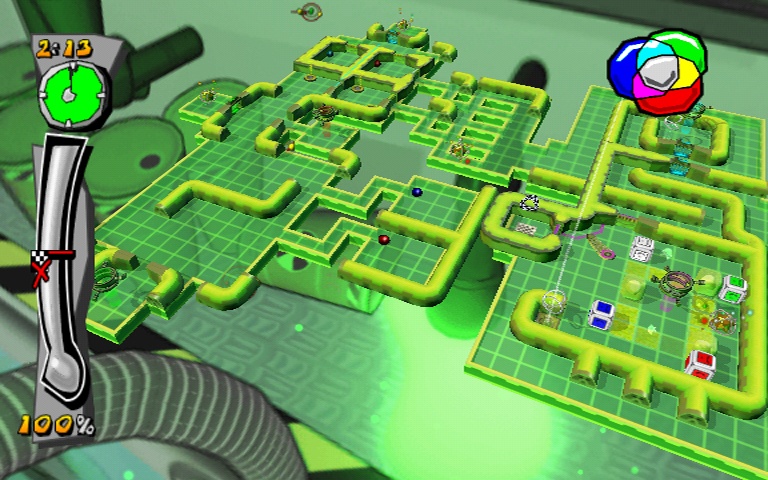Even since its starting point on the PSP, Mercury was always meant to be played with tilt control. Deep in the vaults at developer Ignition Entertainment lay a motion-sensitive adaptor for the console that never saw the light of day. So when Nintendo revealed that the Wii would offer a controller with such a feature, a conversion for the console was pretty much assured. While Mercury Meltdown Revolution is effectively the PSP game with a few new levels, the implementation of the Wii Remote is faultless, refining the experience and making it more enjoyable than before. What's more, it's a game with immense longevity, and if you're a fan of puzzle games, you shouldn't miss out.

The basic principle of Mercury is to guide blobs of metallic liquid around a maze. Points are awarded for speed and accuracy, meaning that you need to move quickly while preventing your mercury from dripping over the edge. While those are the basics, there are a great number of obstacles to overcome as you progress. For example, some obstacles will solidify your mercury or make it runny, others will attract it or repel it, and the most annoying creatures in the game will eat your mercury if you go near them. Once you throw in dexterity tests that involve escalators, moving platforms, and a variety of surfaces, you have a fairly tricky puzzle game.
While all these features were also present in the PSP game, the attraction of the Wii version is its intuitive and well-implemented control system. Holding the Wii Remote as you would a DS, you tilt the controller to angle the maze itself, with gravity dragging the mercury along in that direction. And that's pretty much it--the only other controls are for the camera; the D pad is used to rotate or pan and the 1 and 2 buttons are used to zoom in or out. It may sound like the most simple control system of all time, but it fits the game perfectly and has been implemented incredibly well. The controller responds to subtle movement without feeling twitchy, and you don't have to hold it with spirit-level accuracy to keep the level flat.
Mercury Meltdown Revolution doesn't have a convoluted backstory that explains why you're rolling metal around these mazes; it simply presents eight laboratories with 16 test tubes each to represent all the levels on offer. They're made up of a combination of levels from the PSP game (but have been reordered slightly) and brand-new ones created especially for the Wii version. The more mercury you get to the finish line on each level, the fuller its test tube becomes, and you progress in this fashion to open up the labs that are locked at the start of the game. This structure means that you don't have to beat every level to get to the next lab, nor do you need to complete them within the recommended time frame. Although most levels take no more than a minute to complete, they usually require a bit of thinking and at least a couple of attempts to finish. Those who want to reserve a spot on the scoreboard will need to play over and over to perfect their runs.
The designers of Mercury Meltdown Revolution have produced levels that are both inventive and challenging. These levels also offer plenty of variety and a fair learning curve. It can be annoying to play the same level over and over, but the puzzles themselves are logical. Crucially, the accurate control system means that it's always your own fault when you fail. The most consistent challenge in the game is to use coloured mercury to activate colour-coded gates and buttons. Red, green, and blue spray points are dotted around many of the levels, while a chart in the corner of the screen shows you how to mix colours. For example, you'll need to push your blob against sharp objects to split it into two, and by combining two different coloured blobs you can create all-new colours to solve many of the puzzles in the game.
As you play through the main game, you'll be able to unlock five party games. Far from being poorly designed afterthoughts, there are a couple of really good minigames to be found in this mode. The highlights are rodeo, where you must to keep your blob of mercury on a platform while a computer-controlled fan tries to blow you off, and shove, which plays like a science-class version of bowls. There's also paint, where you must use your mercury to colour more of the level than your opponent, and metrix, which is a puzzler along the lines of Tetris or Lumines. Only one game called race, a poorly conceived Wipeout-esque racer, fails to deliver. It's also a shame that, along with the main game itself, the party games can't be played in multiplayer.

On a technical level, Mercury Meltdown Revolution is a solid if not ostentatious entry into the Wii catalogue. The graphical style may be colourful and cartoonlike, but there are some nice touches if you zoom in to look at the mercury itself. There are lots of little scratches on the surface, while it rolls around the world in a convincingly realistic manner. Perhaps the most important point is that the game has a consistently smooth frame rate, and while the menus are fairly basic, presentation is solid overall. Audio effects tend to be perfunctory, with mechanical grinding for the environments and a generic liquid sound for the mercury. One anomaly is that the mercury lets out a little yelp whenever you drop any off the side; it feels strange that the designers chose to give the mercury a personality trait in this way, but it kind of fits in with the cartoon feel overall. The electronic music is mostly whimsical in nature, but there are recognisable background effects if you're using a Dolby Pro Logic II sound system. The game also offers 480p resolution, as well as support for the classic and GameCube controllers for any traditionalists out there.
While Mercury Meltdown Revolution is essentially the same game as its PSP counterpart, the Wii's control system refines its gameplay, which makes it the definitive version as a result. The sheer amount of levels gives the game plenty of longevity, while the quality of the design means that they're always fun without being complicated. And while there may not be many party games, the majority of the games are enjoyable diversions that you'll actually want to play more than once. There's still room for improvement, particularly given the absence of a multiplayer mode, but Mercury Meltdown Revolution is a great fusion of game and hardware, as well as the Wii's best puzzle game so far.